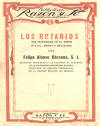|
James H. Roth
Roth, Rotary and the Church.
The selection of James H. Roth to represent Rotary in the predominantly catholic world, had a good reason.
To answer the question “Why James H. Roth” it is necessary to look at what was happening then.
 Rotary had started in Chicago in 1905. Rotary had started in Chicago in 1905.
After a few years it had expanded to
more cities in the United States and
then to Canada, Great Britain, and
after World War I to Cuba and other
countries. In 1920 the first Rotary Club
was formed in Europe: it was Madrid,
Spain.
By 1924 there were more clubs
in Norway, The Netherlands, France,
Denmark, Belgium and Italy.
Until that time, the Catholic Church
had cautiously watched the spread of
the Rotary movement. This attitude
turned to apprehension, however,
when Rotary Clubs were started in
cities of South America, Spain and
France.
The first to sound the alarm was the
French newspaper “La Croix”.
La Croix was a very influential newspaper in France. It was founded in 1880 and was eminently catholic and conservative.
In the (above) editorial published in the April 15, 1925 issue of La Croix, Rotary International is accused of being an
Anglo-American Freemason organization, intent in taking roots in Europe.
By some strange reasoning and manipulation of ideas, the Rotary wheel is equated to the Masonic symbol : the pyramid
with the eye. Rotarians become synonymous with Freemasons. The supposed secrecy of the meetings and the way members are
selected constitute, to La Croix, further proof of the Masonic spirit. The principles of Rotary are “empty, vague,
inconsistent, and vulgar”.
A few years later, on April 19, 1929, a book written by a Jesuit, Felipe Alonso Bárcena was published in Spain.
It contained a comprehensive analysis of Rotary, making reference to the contents of the Statutes, the By Laws and the
Code of Ethics.
According to the author of the book, it is clear that those writings prove without a doubt that Rotary members must be
Freemasons. However, this is not the major sin of the organization.
What makes it satanic is the fact that no reference to God is included, and men from all
 denominations, including atheists are
accepted on an equal basis. denominations, including atheists are
accepted on an equal basis.
The book also presents pastoral letters, from all the bishops in Spain, condemning Rotary and very clearly
stating that true Catholics should abstain from associating with Rotary.
From the view point of Rotary, it was a very damaging campaign. New Rotary Clubs recruited members from the
upper class in the cities; the great majority of the upper class in Central and South America were devout Catholics,
who paid attention to the voices from the pulpit. Those voices were telling them that it was wrong to associate
with Rotary. How could Rotary neutralize that influence?
James H. Roth was a devout catholic and a Knight of Columbus. The Order of the Knights of Columbus was
chartered in Connecticut in 1882. It has been called "the strong right arm of the Church," and has been
praised by popes, presidents and other world leaders, for support of the Church, programs of evangelization and Catholic
education, civic involvement and aid to those in need.
James H. Roth was also very fluent in Spanish and Portuguese, not only the language, but very knowledgeable
about the idiosyncrasies of the people who spoke those languages.
He had diplomatic experience in South America, he was a charter member of the Rotary Club of Lima, and he was a
charismatic individual: all those qualities made him the ideal Rotary messenger.
There is no question that his first year in Spain had an impact.
In his book, “Los Rotarios”, Felipe
Alonso Bárcena dedicates one page to James H. Roth.
 "Mr. Roth is criticized for his words about Rotary, "Mr. Roth is criticized for his words about Rotary,
to quote:
"“There is absolute religious tolerance. The catholic
will be, within the Rotary Clubs, a better catholic;
the protestant, a better protestant; the Hebrew
will also firm up his beliefs and will remove all
intransigence, passion or hate the may have. The
non religious citizen will have his conscience
blessed in the bosom of his club”.
Felipe cannot believe those words came from the
mouth of a catholic: “Such digression and
aberration of ideas in a catholic seem to surpass the
limits of credibility”".
In the October 1927 issue of El Rotariano
Argentino, Mr. Roth talks about his mission on
behalf of Rotary: “ . . . to dispel the doubts of some
Catholics, as a Knight of Columbus . . . Chile, the
United States and Cuba have catholic priests
(members of Rotary)”.
He knew perfectly well the challenges ahead, and
he was confident he would be able to answer all
questions asked by the prospective members of the
clubs to be formed. The success of his mission cannot be questioned.
From 1925 to 1942 more than 170 new Rotary Clubs had been created as a direct result of his
intervention. Chesley Perry had chosen the right man, at the right time. |

